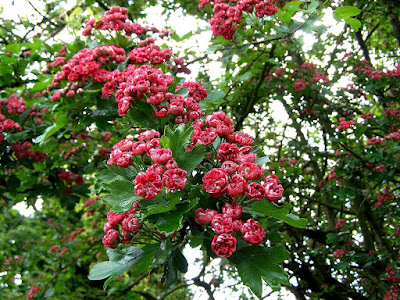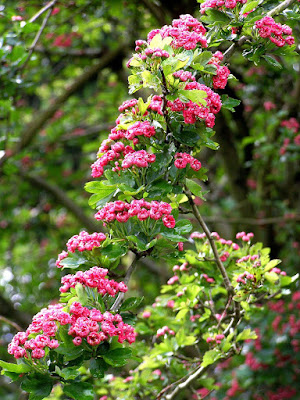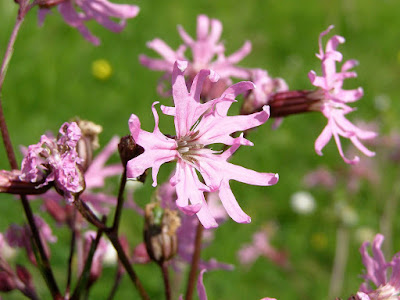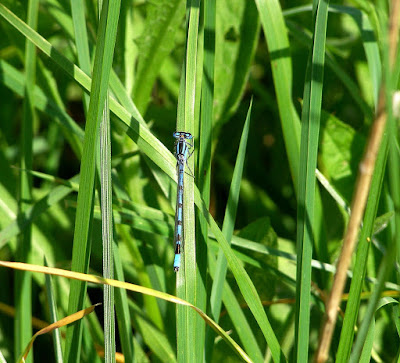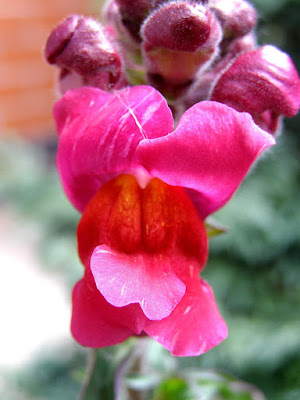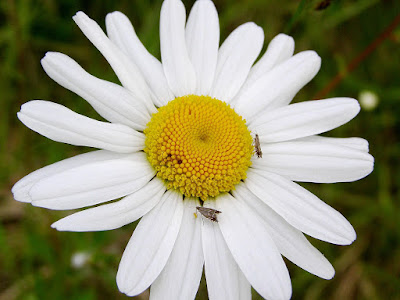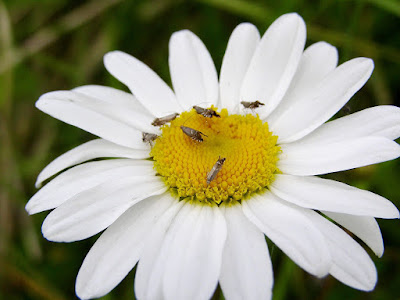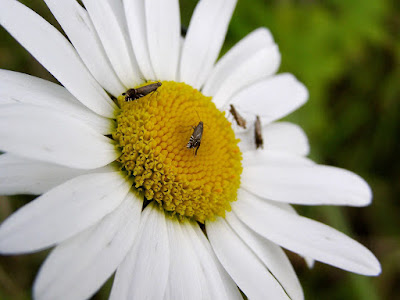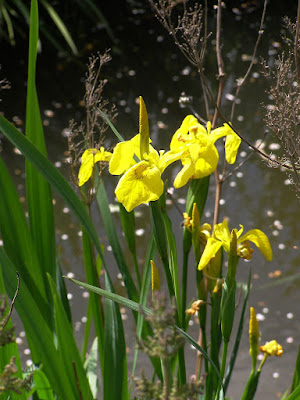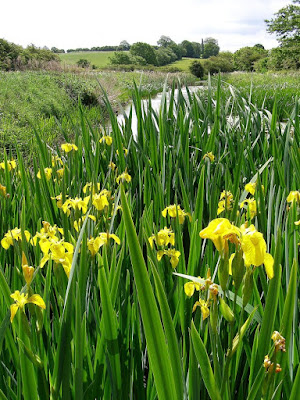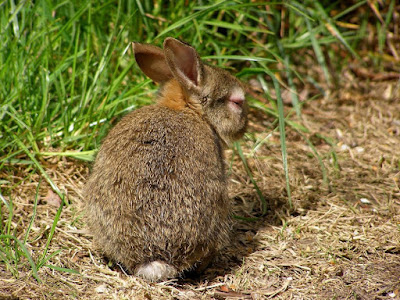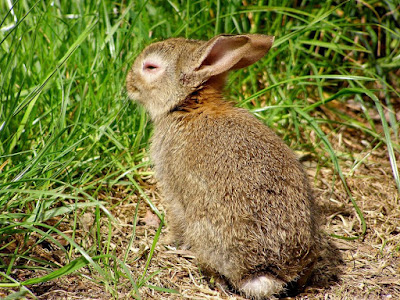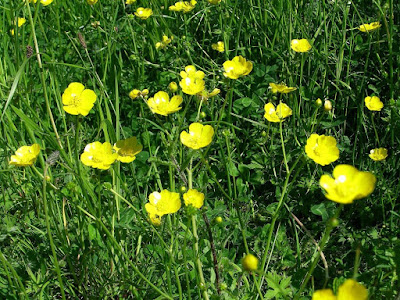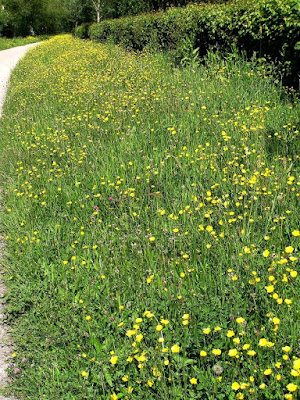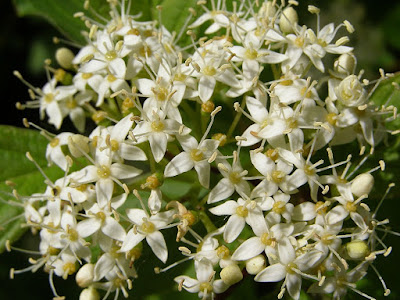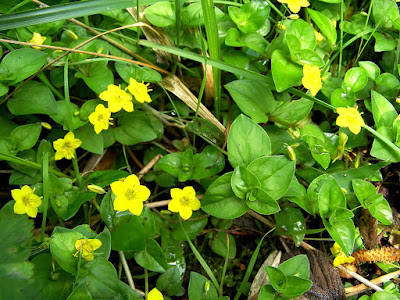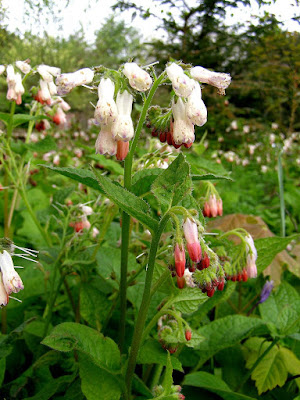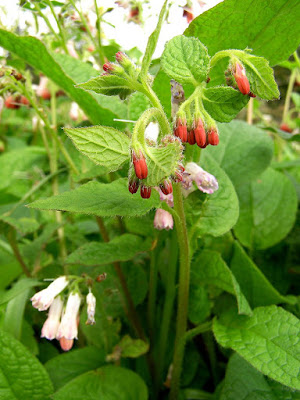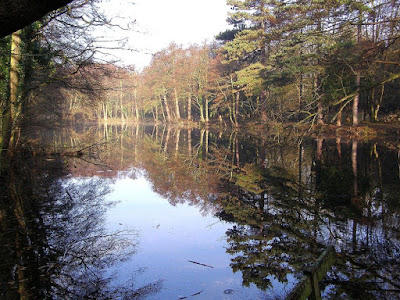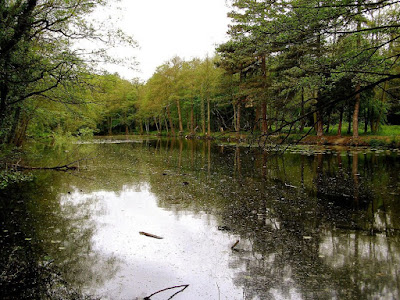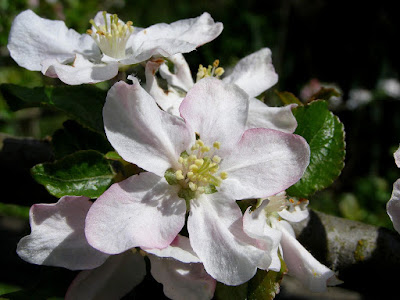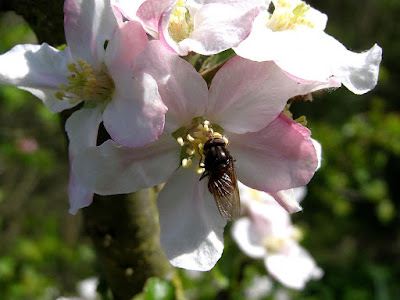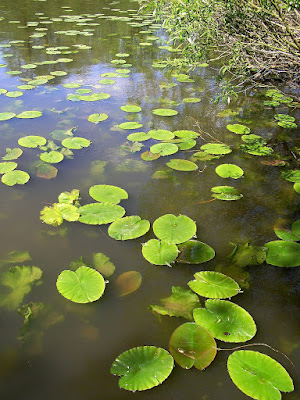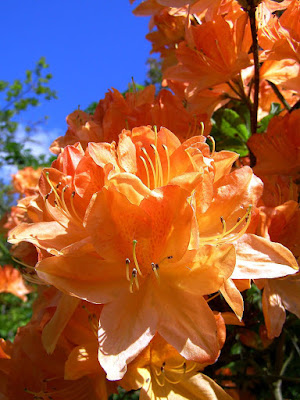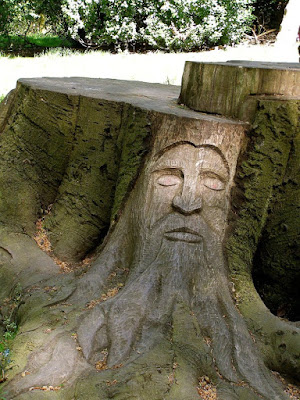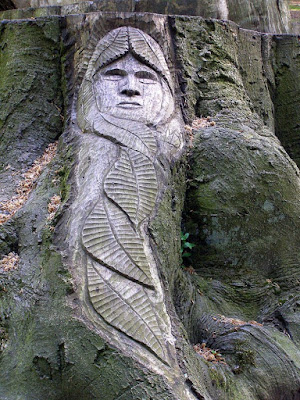Welcome to my blog. Don't expect anything too high-tech or flashy, this is simply a 'diary' to share some of my photos, thoughts and observations - with a particular bias towards the natural world and the countryside around my home.
Sunday 31 May 2009
Strange 'pimples'
I have seen these many times in the past and always thought they were formed by the action of gall wasps. well, I was wrong. They are a type of gall, but not produced by insects at all. They are in fact the result of infestation by a mite called Aceria macrorhynchus. The name is much bigger than the mite!
As you can see from the scale on the picture, these mites are indeed minute! At least ten of them would comfortably sit on the head of a pin. The female mites spend the winter in crevices in the bark, but emerge to feed on the young leaves as they unfurl. Galls arise where the mites have been feeding, and one mite can cause many galls. Later, the mites lay their eggs in some of the galls, and their developing larvae feed on the tissue inside, emerging in the autumn.
Saturday 30 May 2009
Pinks and Reds
Tumbling over the fence of a garden which backs onto the trail, this double flowered variety certainly gives good value.
Moving on, we find a much smaller flower growing around the lake. These pink flowers belong to the Ragged Robin (Lychnis flos-cuculi).
A great favourite of many species of butterfly and the long-tongued bees, numbers of these flowers have declined rapidly in recent years due to loss of habitat. The name comes from it's rather ragged looking flowers.
Another pink flower is to be found in abundance, growing around the now derelict entrance to the American Adventure Theme Park, near by. These belong to the Weigela. Again, a garden shrub, not a native, but still worthy of note.
Actually a native of Eastern Asia, they are named after a German scientist Christian Ehrenfried Weigel.
Friday 29 May 2009
Damsels and Dragons
Firstly the Damsel. In this instance it was a Common Blue Damselfly (Enallagma cyathigerum). Fluttering through the grasses around the lakes, they shone vivid, electric blue.
Getting back home and pottering around the garden, I noticed that the Snapdragon (Antirrhinum majus) which self-seeded in the garden last year was beginning to bloom again. Taking up the camera and getting in close, I ventured into the jaws of this particular dragon...
Called 'Snap'-dragon because when squeezed laterally, the flower opens and closes like the mouth of a dragon. Snapdragons used to belong to the Scrophulariaceae family, but recent research has delved into their DNA and as a result, they have been ousted from that family and added to the Plantaginaceae family. This makes them relatives of the common weeds, Plantains. So that's cleared things up then!
Further to yesterday's blog entry, I have now identified the diminutive moths on the Oxe-eye daisys. They are in fact called Cocks Foot Moths (Glyphipterix simpliciella). They are called this because the larval foodplant is mainly the grass Cock's Foot (Dactylis glomerata).
Thursday 28 May 2009
Ox-Eyes and Birds feet
These blooms were covered in small moths which I am still trying to identify - I will get back to you on that!
The children's game 'He loves me, he loves me not' originally came from a French game using this flower, known as 'effeuiller la marguerite'.
Apparently, the unopened flower buds, when marinated, can be used in cooking as you would use capers.
Growing along side these statuesque flowers, were the more diminutive blooms of the Birds-Foot Trefoil (Lotus corniculatus).
Called Bird's-Foot because of the arrangement of it's seed pods when fruiting, it is a member of the Pea family and a very useful forage crop for livestock. Excellent as a part of silage and hay and a source of nectar for many insects. As a legume, it also assists in soil improvement as it helps lock nitrogen into the soil.
Wednesday 27 May 2009
Iris
These yellow iris or 'Yellow Flag' (Iris pseudacorus) spread by way of their rhizomes (underground stems) and by distributing their seeds on the water. Used to growing in the mud of the waterside in oxygen-free conditions, they can also cope for short periods of drought.
Yellow Iris have been used as water treatment agents as they take up heavy metals from the water. They have been used in herbal medicine as an emetic or vomit inducer!
Strange that something so beautiful can be seen as 'vomit-inducing'. But on a sunny day with the golden-yellow flowers shining against a calm, watery backdrop, there can be few more delightful scenes.
Tuesday 26 May 2009
Bunny!
We thought it strange that the little creature was taking little notice of us as we approached and came to the conclusion that there must be something wrong. Upon looking closer at the photos I took, it is clear that the poor little soul was suffering from that awful disease, myxomatosis. Although in the early stages of the disease, it was still clearly affecting it as the reddening of the eyes indicates.
I am not a religious person and don't believe in heaven and hell. But, if I am wrong and there is such a place as hell, I hope that the person who deliberately introduced this abomination into Europe and caused such unimaginable suffering to millions of animals, will rot for all eternity in the hottest, most hideous furnace that Beelzebub can devise.
Monday 25 May 2009
Hottentot
As the scientific name suggests, these plants have edible fruits, although these are said to be quite sour. More familiar to those who holiday in the Mediterranean area, they are succulents of the Stone Plant family. Highly invasive, they have spread to Britain from private gardens, often brought in from the Med', but they are in fact native to South Africa.
They grow very quickly and each stem can put on up to 3ft a year. It is for this reason that they have become such a problem all round the world.
The flowers are very popular with bees and beetles and, where they grow in their native Africa, they are a great favourite with antelope and baboons. No baboons or antelope on The Lizard, so we'll have to just appreciate the flowers for their pink-hued beauty.
Sunday 24 May 2009
Buttercups
A rather invasive species, it has been introduced to many parts of the world where it is not a native, often with disastrous effects.
There are many species and sub-species(more than 400) in the buttercup family. This one has prostrate runners which creep along the ground, rooting at 'nodes' along it's length and thus spreading.
The flowers are well known to us all as being very shiny. Who hasn't held a picked Buttercup under someones chin, looking for a golden, reflected glow on the skin to 'see if they like butter'? Most buttercups - including this one - are poisonous causing blistering of the mouth. When growing and fresh, they have a very nasty taste, so grazing animals tend to avoid them. However when cut and dried with the mown hay, they lose their poisons and are harmless.
Friday 22 May 2009
Snails
On closer inspection these snails are quite beautiful. Their shells are shiny and marked to a greater or lesser extent, with bands of colour.
The 'base' colour of the shells range from a pale greenish white, to reddish-brown.
One in particular was very handsome - if you can ascribe that adjective to a snail! Almost golden in the sunlight with clear stripes spiraling around it's shell.
Seemingly intent on getting to the other side of the path before becoming the lunch of a thrush, all of these snails, despite their differing appearance, are the same species. The White-Lipped Snail (Cepaea hortensis). The name refers not to the actual 'lips' of the snail, but to the white (or paler) edge - or lip - to the shell opening.
These snails are hermaphrodite and have a strange love life and mating ritual. This involves mature snails producing a hard, chitinous 'dart' which it then attempts to stab into any available part of it's mate. This stabbing is done in a rather haphazard way and sometimes with enormous force. They have been known to impale internal organs or even to stab right through the recipient and out the other side! This weird behaviour is not for the transference of sperm or eggs, but just a preliminary part of mating. Strange!
Thursday 21 May 2009
Historical Background - part 2
The manor stayed in the Canteloupe family for the next 90 years until the death of Nicholas' Great Great Grandson William. William had no heir and the issue of inheritance was the subject of much debate until it was decided that a distant cousin, William la Zouche was declared heir. The manor stayed in the Zouche family until 1485 when the family found themselves 'on the wrong side' at the battle of Bosworth.
Following the battle, the land was taken into the Savage family, and remained with them until 1608 when it was sold to Sir John Manners. Sir John is an ancestor of the present Duke of Rutland, who remains Lord of the Manor of Ilkeston to this day.
The Miller Mundy's made their money through mining. This was to be the ultimate downfall of the great hall. The owner of the hall in 1922, one Godfrey Miller-Mundy, sold the entire estate to the Shipley Coal Company (a company created by some of his ancestors). The mining company then began to mine under the hall, into a supporting pillar of coal. This, of course, proved to be disasterous and the hall began to subside. By 1943 it had to be demolished.

By 1970, Derbyshire County Council bought the estate and thus began the Shipley Country Park. More information Here.
Wednesday 20 May 2009
Historical Background - part 1
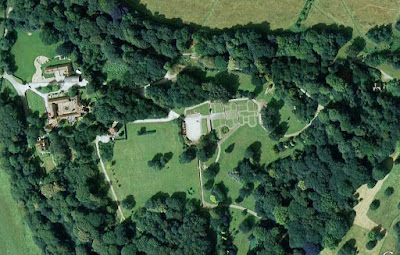
The Estate has been known since the Norman conquest when the area was given to Gilbert of Ghent along with further land in 15 other counties. It is thought that it was a gift from William l for Gilbert's support during the conquest. There had been a hunting lodge on top of the hill - around the position of the old hall.
Shipley was then an important hunting estate for the rich and powerful of Norman England.
Following Gilbert's death in 1094, the Manor of Ilkeston passed to his son Walter of Ghent. Walter died around 1134 when the estate passed to the Muskham family in about 1139. Robert de Muskham is thought to have been the founder of St. Mary's Church, Ilkeston. Robert's son, Hugh inherited the land and in turn passed it to his own son, another Robert. It then passed to Isabell, daughter of the first Robert de Muskham and through her, to the de Gresley family via her marriage to Ralph de Gresley in about 1216. Ralph, being described as 'languid' in 1228, passed the manor to his daughter Agnes and her husband Hugh Fitz Ralph. It was this Hugh who was granted Ilkeston's market charter in 1252.
Tuesday 19 May 2009
Dogs and Jennies
This particular Dogwood is the Siberian, White, or Red-Barked Dogwood (Cornus alba). The masses of small, white flowers forming flower heads known as cymes.
Further along the walk we found these Dog Roses just beginning to bloom.
These Dog Roses (Rosa canina) are actually one of 20 or 30 different sub-species all generically called Dog Roses. The pale pink and white flowers are well known to most of us as part of the typical English hedgerow. As are the red fruits which follow them in the Autumn known as Rose Hips.
Lastly, as we returned home, we found this attractive little flower growing - or should I say scrambling - along the side of the footpath.
These bright yellow blooms belong to an easily overlooked plant called Creeping Jenny (Lysimachia nummularia). Also called Moneywort, Herb Twopence and Twopenny grass, it is sometime cultivated as a garden plant as it is an excellent ground cover plant.
Monday 18 May 2009
Columbidae
A closer look at the colouring of the bird reveals it's true beauty. The pale grey with a pinkish wash, coupled with the iridescence of the feathers around the neck, surely makes this one of our more colourful birds.

Sunday 17 May 2009
Blackbird
Members of the Thrush family, they have a wonderful singing voice and often incorporate parts of other birds' songs in their own repertoire. One particularly amusing bird near our home was last year to be heard mimicking (Rather well) a reversing lorry!
One of Britain's most common bird species, their numbers may reach about 15 million individuals during the winter, swelled by a European influx especially in harsh weather. It is thought about 5 million pairs breed in the UK. Here is a particularly good recording of a Blackbird singing, from YouTube. (Try to ignore the person in the background blowing her nose half way through!)
Saturday 16 May 2009
Comfrey
These bright little flowers belong to a comfrey plant. Comfrey has for many years been one of the most useful plants in the garden. A hint of it's usefulness comes from one of it's common, country names, 'Knitbone'. It was used as an aid to all sorts of 'bone' problems including breaks, sprains and arthritis. Other uses include gastric problems, ulcers and a whole manner of skin conditions such as acne and burns. Further uses include aiding with teeth formation in children.
Among the more bizarre claims of old was that it could 'restore a woman's virginity' by immersion in a Comfrey Bath! Modern medicine has proven many of the 'old wives tales' as there are numerous helpful constituents including mucilage, steroidal saponins, tannins, pyrrolizidine alkaloids, inulin, vitamin B12 and proteins. Internal usage should be avoided however as it can cause liver failure. Excessive ingestion of comfrey leaves has been linked to at least one death.
Comfrey is well known to gardeners as the plant, when placed in the compost heap is a great aid to decomposition of the other constituents of the heap, adding nitrogen as it does so. Lets hear it for the very useful Comfrey plant.
Friday 15 May 2009
Seasonal Differences
Compare to the recent image....
The area in question is known locally as the 'Beauty Spot'. Historically very significant, this was once a reservoir supplying drinking water to Ilkeston until the early 20th century. The water came from several sources including the Oakwell Stream, pumped water from the Kirk Hallam Colliery and water from the Nutbrook. After this period, the area was used for recreation. Boating, walking and even occasional firework displays and concerts.
Thursday 14 May 2009
Cherry Pink....
They look rather pink to me and as we saw a little while ago, the cherry flowers were whiter than white. It seems that the local insects are particularly fond of the apple blossom too.
Further round the parkland and on towards Osbourne's Pond and the water lilies are beginning to lift their leaves to the sun. Hopefully it will not be too long before the flowers follow.
Wednesday 13 May 2009
A Riot of Colour
Seen against the blue sky, these bright orange beauties looked as fine as any exotic bloom.
Carrying on through the woodland atop the hill, we came across a couple of 'woodland folk'. Seemingly keeping a silent eye on the goings on of the Shipley Estate they might hark back to a time of Green Men and woodland spirits.
Originally seen as a sign of rebirth and the coming Springtime plenty, the Green Man has been around for well over 1000 years. Green Women are rarer but there seems to be one in Shipley Woods.


